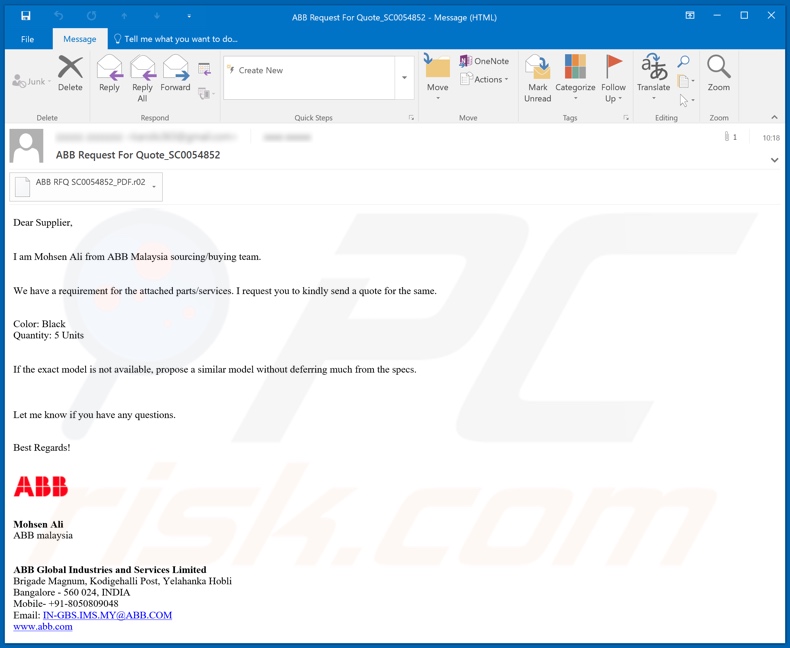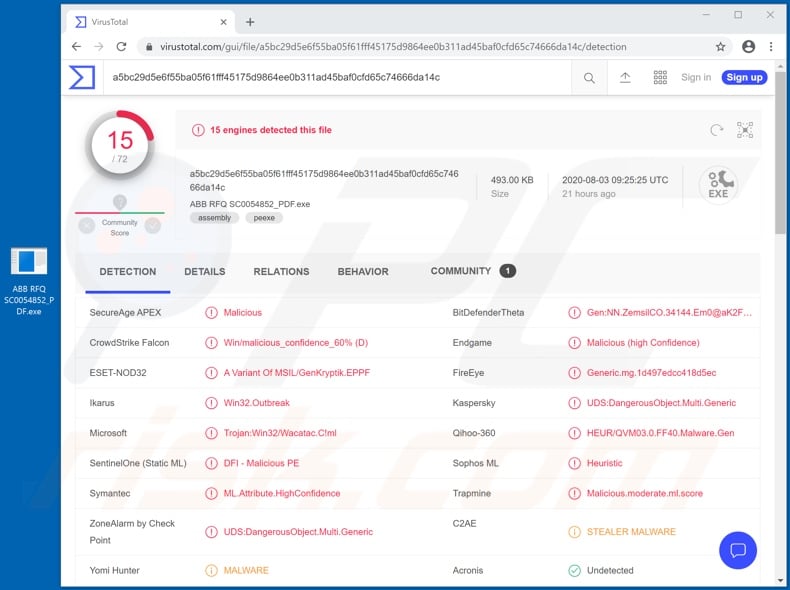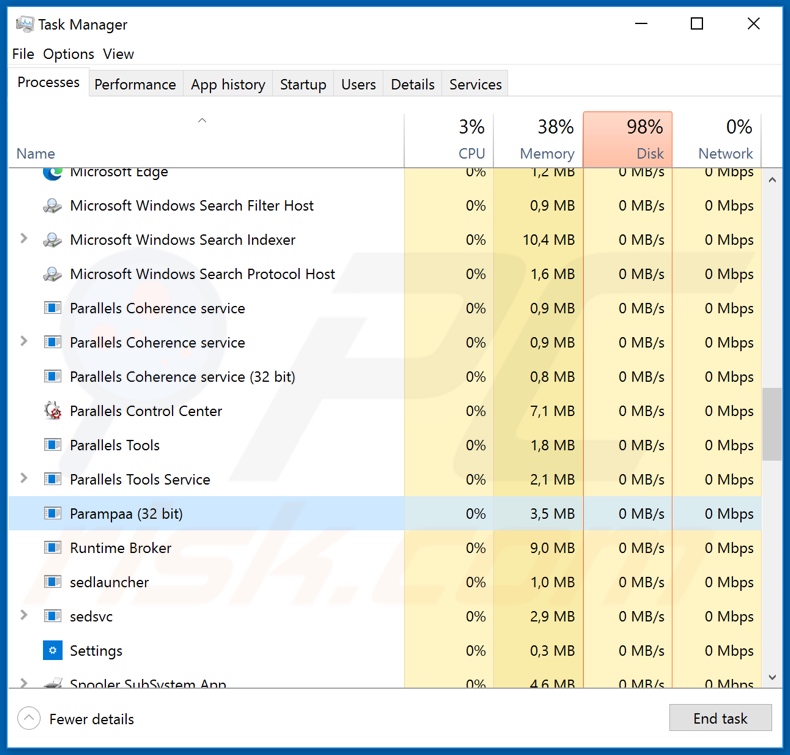Avoid infecting your system with malware through fake ABB emails
Phishing/ScamAlso Known As: ABB email spam
Get free scan and check if your device is infected.
Remove it nowTo use full-featured product, you have to purchase a license for Combo Cleaner. Seven days free trial available. Combo Cleaner is owned and operated by RCS LT, the parent company of PCRisk.com.
What is "ABB Email Virus"?
"ABB Email Virus" refers to a spam campaign designed to proliferate the AgentTesla Remote Access Trojan (RAT). The term "spam campaign" is used to define a mass-scale operation, during which thousands of scam emails are sent.
The messages, distributed via the "ABB Email Virus" spam campaign are disguised as mail from the Malaysian branch of the ABB Group, a multinational corporation primarily dealing in robotics, power, heavy electrical equipment and automation technology. Note that these bogus emails are in no way connected to the genuine ABB corporation.

The scam emails with the title/subject "ABB Request For Quote_SC0054852" (this might vary) ask recipients to provide a quote for the listed parts and services. The details of the supposed order are not included in the body of the message - it is implied that the information is contained in the attached file.
The only data concerning the fake order is that the required quantity is specified as five, and the color as black. Additionally, the emails state that should the requested model be unavailable, recipients are asked to propose a similar one with specifications matching the original as closely as possible.
Since these are scam emails, none of the information provided by them is genuine, however, if recipients are tricked into opening the attached malicious file, the infection process/chain of the AgentTesla RAT is initiated. Remote access Trojans enable remote access and control over the infected device.
Some can allow user-level control over the machine, including hardware, software and content stored in the system or accessed through it. RATs can have a wide variety of dangerous functionality, which can cause serious problems to the victims. The primary function of AgentTesla is data theft.
To summarize, trusting the fake ABB emails can lead to system infections, financial loss, serious privacy issues and even identity theft. If it is known or suspected that the AgentTesla RAT (or other malware) has already infected the system, use anti-virus software to remove it immediately.
| Name | ABB email spam |
| Threat Type | Trojan, password-stealing virus, banking malware, spyware. |
| Hoax | Emails are disguised as quotation requests from ABB. |
| Attachment(s) | ABB RFQ SC0054852_PDF.exe |
| Detection Names | Avast (Win32:PWSX-gen [Trj]), BitDefender (Trojan.GenericKD.43586794), ESET-NOD32 (A Variant Of MSIL/Kryptik.XEY), Kaspersky (HEUR:Trojan.MSIL.Inject.gen), Full List Of Detections (VirusTotal). |
| Symptoms | Trojans are designed to stealthily infiltrate the victim's computer and remain silent, and thus no particular symptoms are clearly visible on an infected machine. |
| Payload | AgentTesla |
| Distribution methods | Infected email attachments, malicious online advertisements, social engineering, software 'cracks'. |
| Damage | Stolen passwords and banking information, identity theft, the victim's computer added to a botnet. |
| Malware Removal (Windows) |
To eliminate possible malware infections, scan your computer with legitimate antivirus software. Our security researchers recommend using Combo Cleaner. Download Combo CleanerTo use full-featured product, you have to purchase a license for Combo Cleaner. 7 days free trial available. Combo Cleaner is owned and operated by RCS LT, the parent company of PCRisk.com. |
"Deutsche Bank Email Virus", "Sincere Apologies For This Delay", "Google Pay Email Virus" and "Philippine Overseas Employment Administration" are some examples of malware-proliferating spam campaigns. This is a popular distribution technique for various types of malicious programs such as Trojans, ransomware, cryptominers, and so on.
The deceptive emails are usually presented as "urgent", "important", "priority" and similar. They might even be disguised as mail from legitimate companies, organizations, institutions and other entities. Note that scam messages are not used exclusively for distribution of malicious content.
These emails are also used for phishing and other scams. Regardless of what deceptive mail claims or how it operates, the purpose is identical: to generate revenue for the scammers/cyber criminals responsible.
How did "ABB Email Virus" infect my computer?
Systems are infected through dangerous files, which are sent in spam campaigns. These files can be attached to the emails and/or the messages can contain download links to the files. Infectious files can be in various formats such as executables (.exe, .run, etc.) archives (RAR, ZIP, etc.), Microsoft Office and PDF documents, JavaScript, and so on.
When the files are executed, run or otherwise opened, the infection process is started. I.e., when a malicious file is opened, download/installation of malware is triggered.
How to avoid installation of malware
You are strongly advised against opening suspicious and/or irrelevant emails, especially those with any attachments or links found in them, as this can result in high-risk infection. Additionally, use Microsoft Office versions released after 2010.
These versions have "Protected View" mode, which prevents infectious documents from executing malicious macro commands when they are opened.
As well as spam campaigns, malware is also proliferated via untrusted download channels (e.g. unofficial and free file-hosting websites, Peer-to-Peer sharing networks and other third party downloaders), illegal activation tools ("cracks") and fake updaters.
Therefore, it is important to download from official/verified sources and activate/update programs with functions provided by legitimate developers. To ensure device integrity and user safety, it is paramount to have a reputable anti-virus/anti-spyware suite installed and kept updated.
This software must be used to perform regular system scans and to remove detected/potential threats. If you have already opened "ABB Email Virus" attachment, we recommend running a scan with Combo Cleaner Antivirus for Windows to automatically eliminate infiltrated malware.
Text presented in the fake ABB email message:
Subject: ABB Request For Quote_SC0054852
Dear Supplier,
I am Mohsen Ali from ABB Malaysia sourcing/buying team.
We have a requirement for the attached parts/services. I request you to kindly send a quote for the same.
Color: Black
Quantity: 5 Units
If the exact model is not available, propose a similar model without deferring much from the specs.
Let me know if you have any questions.
Best Regards!
Mohsen Ali
ABB malaysia
ABB Global Industries and Services Limited
Brigade Magnum, Kodigehalli Post, Yelahanka Hobli
Bangalore - 560 024, INDIA
Mobile- +91-8050809048
Email: IN-GBS.IMS.MY@ABB.COM
www.abb.com
Screenshot of VirusTotal detections of the malicious attachment ("ABB RFQ SC0054852_PDF.exe"), distributed via "ABB Email Virus" spam campaign:

Screenshot of the malicious executable process in Windows Task Manager ("Parampaa" - the process name might vary):

Instant automatic malware removal:
Manual threat removal might be a lengthy and complicated process that requires advanced IT skills. Combo Cleaner is a professional automatic malware removal tool that is recommended to get rid of malware. Download it by clicking the button below:
DOWNLOAD Combo CleanerBy downloading any software listed on this website you agree to our Privacy Policy and Terms of Use. To use full-featured product, you have to purchase a license for Combo Cleaner. 7 days free trial available. Combo Cleaner is owned and operated by RCS LT, the parent company of PCRisk.com.
Quick menu:
- What is ABB email spam?
- Types of malicious emails.
- How to spot a malicious email?
- What to do if you fell for an email scam?
Types of malicious emails:
![]() Phishing Emails
Phishing Emails
Most commonly, cybercriminals use deceptive emails to trick Internet users into giving away their sensitive private information, for example, login information for various online services, email accounts, or online banking information.
Such attacks are called phishing. In a phishing attack, cybercriminals usually send an email message with some popular service logo (for example, Microsoft, DHL, Amazon, Netflix), create urgency (wrong shipping address, expired password, etc.), and place a link which they hope their potential victims will click on.
After clicking the link presented in such email message, victims are redirected to a fake website that looks identical or extremely similar to the original one. Victims are then asked to enter their password, credit card details, or some other information that gets stolen by cybercriminals.
![]() Emails with Malicious Attachments
Emails with Malicious Attachments
Another popular attack vector is email spam with malicious attachments that infect users' computers with malware. Malicious attachments usually carry trojans that are capable of stealing passwords, banking information, and other sensitive information.
In such attacks, cybercriminals' main goal is to trick their potential victims into opening an infected email attachment. To achieve this goal, email messages usually talk about recently received invoices, faxes, or voice messages.
If a potential victim falls for the lure and opens the attachment, their computers get infected, and cybercriminals can collect a lot of sensitive information.
While it's a more complicated method to steal personal information (spam filters and antivirus programs usually detect such attempts), if successful, cybercriminals can get a much wider array of data and can collect information for a long period of time.
![]() Sextortion Emails
Sextortion Emails
This is a type of phishing. In this case, users receive an email claiming that a cybercriminal could access the webcam of the potential victim and has a video recording of one's masturbation.
To get rid of the video, victims are asked to pay a ransom (usually using Bitcoin or another cryptocurrency). Nevertheless, all of these claims are false - users who receive such emails should ignore and delete them.
How to spot a malicious email?
While cyber criminals try to make their lure emails look trustworthy, here are some things that you should look for when trying to spot a phishing email:
- Check the sender's ("from") email address: Hover your mouse over the "from" address and check if it's legitimate. For example, if you received an email from Microsoft, be sure to check if the email address is @microsoft.com and not something suspicious like @m1crosoft.com, @microsfot.com, @account-security-noreply.com, etc.
- Check for generic greetings: If the greeting in the email is "Dear user", "Dear @youremail.com", "Dear valued customer", this should raise suspiciousness. Most commonly, companies call you by your name. Lack of this information could signal a phishing attempt.
- Check the links in the email: Hover your mouse over the link presented in the email, if the link that appears seems suspicious, don't click it. For example, if you received an email from Microsoft and the link in the email shows that it will go to firebasestorage.googleapis.com/v0... you shouldn't trust it. It's best not to click any links in the emails but to visit the company website that sent you the email in the first place.
- Don't blindly trust email attachments: Most commonly, legitimate companies will ask you to log in to their website and to view any documents there; if you received an email with an attachment, it's a good idea to scan it with an antivirus application. Infected email attachments are a common attack vector used by cybercriminals.
To minimise the risk of opening phishing and malicious emails we recommend using Combo Cleaner Antivirus for Windows.
Example of a spam email:

What to do if you fell for an email scam?
- If you clicked on a link in a phishing email and entered your password - be sure to change your password as soon as possible. Usually, cybercriminals collect stolen credentials and then sell them to other groups that use them for malicious purposes. If you change your password in a timely manner, there's a chance that criminals won't have enough time to do any damage.
- If you entered your credit card information - contact your bank as soon as possible and explain the situation. There's a good chance that you will need to cancel your compromised credit card and get a new one.
- If you see any signs of identity theft - you should immediately contact the Federal Trade Commission. This institution will collect information about your situation and create a personal recovery plan.
- If you opened a malicious attachment - your computer is probably infected, you should scan it with a reputable antivirus application. For this purpose, we recommend using Combo Cleaner Antivirus for Windows.
- Help other Internet users - report phishing emails to Anti-Phishing Working Group, FBI’s Internet Crime Complaint Center, National Fraud Information Center and U.S. Department of Justice.
Share:

Tomas Meskauskas
Expert security researcher, professional malware analyst
I am passionate about computer security and technology. I have an experience of over 10 years working in various companies related to computer technical issue solving and Internet security. I have been working as an author and editor for pcrisk.com since 2010. Follow me on Twitter and LinkedIn to stay informed about the latest online security threats.
PCrisk security portal is brought by a company RCS LT.
Joined forces of security researchers help educate computer users about the latest online security threats. More information about the company RCS LT.
Our malware removal guides are free. However, if you want to support us you can send us a donation.
DonatePCrisk security portal is brought by a company RCS LT.
Joined forces of security researchers help educate computer users about the latest online security threats. More information about the company RCS LT.
Our malware removal guides are free. However, if you want to support us you can send us a donation.
Donate
▼ Show Discussion